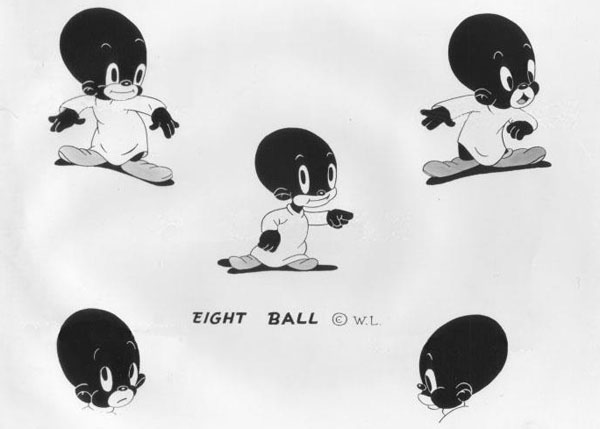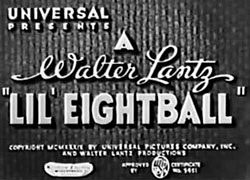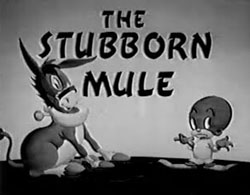
The Stubborn Mule is the debut of Walter Lantz’s short-lived African American star Li’l Eightball. The producer made three films with the character before moving on to the well-received Andy Panda, whose series soon thereafter launched the superstar Woody Woodpecker. Collectively, Eightball’s three episodes capture Lantz’s studio in a state of transition. The producer had just retired his long-running “Oswald the Lucky Rabbit” series, and he started Eightball before Andy. Also, Lantz had just hired Burt Gillett to direct cartoons, and vocal artist Mel Blanc was still early in his career in animated films and not yet exclusively contracted to Warner Brothers.
 In a sense Stubborn Mule establishes the formula for all three cartoons starring Eightball. The protagonist–an African American boy wearing an oversized shirt–hears an argument with which he disagrees, chuckles and proposes to disprove the argument, and engages in slapstick humor while trying and failing to accomplish his goal. The debut finds Eightball offering to show an Italian American vendor how to make the salesman’s stubborn mule move on command. After a series of mishaps, Eightball succeeds.
In a sense Stubborn Mule establishes the formula for all three cartoons starring Eightball. The protagonist–an African American boy wearing an oversized shirt–hears an argument with which he disagrees, chuckles and proposes to disprove the argument, and engages in slapstick humor while trying and failing to accomplish his goal. The debut finds Eightball offering to show an Italian American vendor how to make the salesman’s stubborn mule move on command. After a series of mishaps, Eightball succeeds.
The Stubborn Mule is a disjointed episode in that it flails around in trying to settle on a style of humor. At the beginning, the big-lipped Eightball speaks with multiple multisyllabic words and in grammatically correct sentences, as in “Patience and determination conquer all obstacles.” These sentences attempt humor as a collective oral juxtaposition to Eightball’s physical appearance as an African American, because audiences watching in 1939 would not have been socialized to seeing or hearing African American fictional characters speaking with grammatical correctness on film. Then he speaks in dialect: “I knows how to make friends and influence mules.” But after the salesman leaves Eightball with the mule, the star hardly speaks for the rest of the film, and the humor is more visual than verbal. Eightball’s ethnicity almost becomes incidental, except when he later says, “He evidently don’t recognize strategy when he sees it.”
 In one part the film breaks from the slapstick for a couple of surreal gags. The shadow where the mule sits actually stays on the ground after the mule rises and gallops. Eightball then sits on the shadow, but the mule stands on his hind legs and uses his hands to pull the shadow, as if a rug, out from under Eightball. At the peak of realistic graphics in Hollywood cartoons in the late 1930s, the shadow gags were innovative.
In one part the film breaks from the slapstick for a couple of surreal gags. The shadow where the mule sits actually stays on the ground after the mule rises and gallops. Eightball then sits on the shadow, but the mule stands on his hind legs and uses his hands to pull the shadow, as if a rug, out from under Eightball. At the peak of realistic graphics in Hollywood cartoons in the late 1930s, the shadow gags were innovative.
An even more interesting part is a loose playing with ethnic socialization. Eightball addresses the vendor as “boss,” but a few seconds later, as the vendor leaves, he calls Eightball “boss.” In part the exchange exemplifies the studio’s lack of commitment to fully engaging in ethnic humor. Also, the conversation suggests that Italian Americans were depicted in media as not fully assimilated; the vendor’s accent is as thick as Eightball’s but with better grammar. Himself an Italian American, Lantz had the potential to use The Stubborn Mule as a sly commentary on Hollywood’s portrayals of ethnic minorities. With a more cohesive story and stronger characters, he may have succeeded. Neither of the two remaining episodes starring Eightball are nearly as ambitious.
NEXT MONTH: “Silly Superstition”


 Christopher P. Lehman is a professor of ethnic studies at St. Cloud State University in St. Cloud, Minnesota. His books include American Animated Cartoons of the Vietnam Era and The Colored Cartoon, and he has been a visiting fellow at Harvard University.
Christopher P. Lehman is a professor of ethnic studies at St. Cloud State University in St. Cloud, Minnesota. His books include American Animated Cartoons of the Vietnam Era and The Colored Cartoon, and he has been a visiting fellow at Harvard University.



























Wasn’t Li’l Eightball in “Voodoo in Harlem?”
(That’s the only Eightball cartoon appearance I’m familiar with.)
To answer your question; no. The Lil’ Eightball character appeared in “The Stubborn Mule,” “Silly Superstition,” and “A Haunting We will Go.” The character that morphs from the eight ball ink blot in “Voodoo in Harlem” is a Black African man. Lil’ Eightball is a Black American child. The two different characters bear absolutely no resemblance save for the color of their skin.
Thanks for the clarification, J-man.
(I used to have a 16mm of “VooDoo…” years ago, but haven’t seen it in over 20 years.)
Is that a Motion Pictures for Television TV print?
After you finish “Li’l Eightball”, there’s one character I think you should REALLY do: Jasper, from the Paramount George Pal Puppetoons!
That’s not the mule’s shadow, it’s the imprint of his butt and front shoes – he’s been sitting there so long he made dents in the ground.
Aside from the scene where Eightball skips along as he plays the pipe, there’s not a lot to like in this cartoon.
Mr. L’ehman, this is another one of your excellent and informative articles. I’m looking forward to the next two follow-ups. You have no doubt already noticed that I misspelled your name, which in good humor brings me to a quick point of clarification regarding the spelling of Eightball’s name. The correct spelling is Lil’ Eightball not L’il or Li’l or Lil. The placement of the comma may seem insignificant, but tell that to Lil’ Kim or Lil’ Wayne or Boosie Badazz (formally Lil’ Boosie). We ain’t talkin’ ‘bout Li’l Abner here, if you follow my flow. #LOL
There are several Black characters in animation that I would love to see you analysis in your future columsn; for example: Inki, Jasper, Calvin and the Colonel, and the “Tom and Jerry” character ‘Mammy Two Shoes’, who in my opinion is far-removed from the classic Black maid stereotype portrayed by Petunia and Mandy in the ‘Little Audrey” and “Little Lulu” cartoons, respectively. I believe that Mrs. Two Shoes wasn’t a maid at all, but was instead the homeowner. However, most of all, I would really appreciate if you did a piece on the granddaddy of all animated Black characters; the elusive Sammie Johnsin.
Created over 100 years in 1916, Sammie Johnsin, as I’m sure you already know, was the debut move into animation by cartoonist and film producer Pat Sullivan, and is based on the newspaper comic strip “Sambo and His Funny Noses” by William Marriner. Three years later in 1919, Sullivan’s studio would create the iconic Fritz the Cat. There were 10 Sammie Johnsin shorts produced, and please/hopefully correct me if I’m wrong, but sadly all ten are lost. Again, correct me if I’m wrong, but it appears that Sammie Johnsin is the first Black character in American animation history to have his own series. But what is particularly interesting about these cartoons, is that even though Pat Sullivan was a racist, among several other vile things, in every episode Sullivan scripted Sammie’s character so that in the end he would always outsmart the White kids who tormented him, which was certainly not well-received during that era in U.S. history.
There are a handful of interesting silent cartoons worth discussing. Earl Hurd’s BOBBY BUMPS STARTS A LODGE (1916) boasts above average animation for its time even if it too has its share of racial stereotyping.
Thanks for pointing out the misspelling. I’ll have to make a note of that for my other posts about Eightball. I would be up for posts about the other characters you mentioned.
Jazzman: I think you were referring to FELIX THE CAT (the wonderful, wonderful cat), a character that I truly like and went through so many changes from his original incarnation as a silent cat with expressive tail to the cat that I knew with the Magic Bag of Tricks, but indeed there are folks connected with this site who are working diligently on further materials around FELIX THE CAT…
LIL’ EIGHTBALL is a character I was unfamiliar with until the days of the cartoon revival festivals. I’m sure I’d never seen the character show up on kids’ TV back in the late 1950’s and early 1960’s. I find it interesting that the major studios were so selective on what got out and what was well hidden until animation of the golden age got its proper recognition as art. I managed to see every BOSKO cartoon created at MGM, save for “BOSKO AND THE CANNIBALS”, but at least seven of those nine titles were in heavy rotation for a short time. I hope you get around to talking about the remaining MGM titles which were some of the fastest animation in that era, long before Tex Avery…and, yes, I agree that JASPER from the PUPPETOONS series is well worth discussing, for all it was or all it may have tried to be.
As a whole, the PUPPETOONS series is worth not only a complete DVD restoration, but possibly a book on a scale of the LOONEY TUNES AND MERRIE MELODIES book from Jerry Beck and Will Freidwald. That whole series stunned so many animation fans and casual viewers alike. We’ve seen claymation since, but these were in a class by themselves. Thanks, as always, for these posts, and I’m glad that these films are being talked about individually.
Oops… Freudian slip; you’re right, I did mean to say ‘Felix the Cat.’ Friends and I had watched “Sausage Party” earlier in the day, so it’s obvious where my mind was when I wrote Fritz the Cat. Ha!
Is it wrong that I kinda like Eightball?i
Not really. Although it’s important to recognize the prejudices of the times, (His name and physical design are part of the problem.) I always felt he had more personality than most Lantz characters. There’s really kind of an everyman feel to him in that he’s intelligent but can make foolish mistakes.
Two things struck me:
In the model sheet, when his mouth is open it’s shaped like a cats mouth. That’s weird and doesn’t seem to be in line the typical African sterotype.
The other was the failed humor of Eight Ball and then the vendor calling each other ‘Boss’. Now if it didn’t make you laugh, fair enough. But I can see the gag going two ways. One it’s role reversal, at the beginning the vendor was the ‘Boss’, but at the end when Eight Ball succeeds, he becomes the ‘Boss’. OR, as a white man, I’m constantly referred to as ‘Boss’ or ‘Chief’ non-white store clerks, and guys who have worked around my home. I almost feel like it’s code, on “how to talk to a white guy”. In that light, the joke might might be, two non-whites called each other ‘Boss’, which is typically only said to whites. But I don’t know if that was a thing in the 1930’s.
Either way, nice piece.
I noticed dat about de cat mouf too.
It looks a bit like a baby’s or small child’s mouth, which is probably the reason for it.
Television and TV are the same thing.
Where can I buy these movies